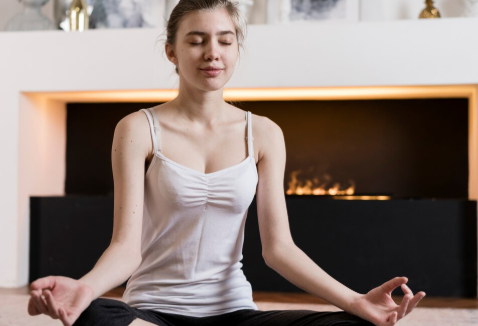Best breathing exercises for anxiety
If you’ve wondered how to breathe to stop anxiety, you’re in the right place. This guide breaks down the best breathing exercises for anxiety—simple, science‑backed patterns you can use anywhere to slow your heart rate, clear mental noise, and feel steady again.
Quick comparison of calming breath techniques
| Technique | Best for | Count pattern | What to remember |
|---|---|---|---|
| Diaphragmatic (belly) breathing | Baseline calm, daily practice | Slow, even inhales/exhales | Belly rises on inhale, chest stays quiet |
| Box breathing | Focus under stress | 4‑4‑4‑4 | Equal inhale‑hold‑exhale‑hold |
| 4‑7‑8 breathing | Fast downshift, sleep | 4‑7‑8 | Longer exhale acts like a brake |
| Resonant/coherent breathing | Nervous system balance | 5–6 in, 5–6 out | About 6 breaths per minute |
| Alternate nostril (nadi shodhana) | Mental clarity, relaxation | Left→right cycles | Gentle rhythm; sit tall |
Diaphragmatic breathing for anxiety (belly breathing)
- Why it works: Engages the diaphragm, boosts parasympathetic tone, and reduces shallow chest breathing.
- When to use: Daily baseline practice; before meetings; during mild stress.
- Posture: Sit or lie down comfortably, one hand on chest, one on belly.
- Inhale: Through your nose for 3–5 seconds, letting your belly rise under your hand.
- Exhale: Through the nose or pursed lips for 4–6 seconds, belly falls; chest stays mostly still.
- Duration: 3–10 minutes, 1–3 times per day.
Tip: If your shoulders lift, you’re chest‑breathing. Slow down and soften the upper body.
Box breathing for stress control (square breathing)
- Why it works: The even rhythm steadies CO2/O2 balance and anchors attention.
- When to use: Acute stress, pre‑presentation, overwhelm.
- Inhale: 4 counts through the nose.
- Hold full: 4 counts, shoulders relaxed.
- Exhale: 4 counts, smooth and steady.
- Hold empty: 4 counts, then repeat 4–8 rounds.
Tip: If holds feel edgy, shorten to 3 counts or skip the holds until comfortable.
4‑7‑8 breathing technique for anxiety
- Why it works: The long exhale signals safety and slows the heart.
- When to use: Nighttime wind‑down, sudden spikes of anxiety.
- Set: Tongue gently on the ridge behind upper teeth; lips parted for the exhale.
- Inhale: Through the nose for 4.
- Hold: For 7 (light, not strained).
- Exhale: Through the mouth for 8 with a soft “whoosh.”
- Rounds: Start with 4 cycles; work up as tolerated.
Tip: Keep the 4:7:8 ratio, even if you must shorten counts at first.
Resonant (coherent) breathing for relaxation
- Why it works: Around six breaths per minute increases heart‑rate variability and calm.
- When to use: Daily nervous‑system training; study breaks; post‑conflict reset.
- Inhale: Through the nose for 5–6 seconds.
- Exhale: Through the nose for 5–6 seconds.
- Flow: No breath holds; just smooth, even waves.
- Duration: 5–10 minutes.
Tip: Imagine breathing to a slow pendulum: in on the swing forward, out on the swing back.
Alternate nostril breathing for relaxation (nadi shodhana)
- Why it works: Balances attention, reduces rumination, and settles the mind.
- When to use: Pre‑sleep unwind (gentle pace), mid‑day mental reset.
- Hand position: Right thumb near right nostril; ring finger near left.
- Start: Close right nostril; inhale left.
- Switch: Close left; exhale right. Inhale right.
- Switch back: Close right; exhale left.
- Rounds: 5–10 cycles, keeping breath soft and steady.
Tip: Sit tall; if lightheaded, pause and breathe normally, then resume with shorter counts.
“Best breathing method during panic attacks”: 60‑second rescue plans
- Physiological sigh (rapid reset):
- Step 1: Inhale through the nose until lungs are almost full.
- Step 2: Take a quick second sniff to “top up.”
- Step 3: Long, unforced exhale through the mouth.
- Repeat: 3–5 times to quickly lower arousal.
- Grounded 4‑8 breaths:
- Inhale: 4 counts through the nose.
- Exhale: 8 counts through the mouth.
- Anchor: Press feet into the floor; name one thing you see, hear, and feel.

Aim for slow breathing to lower heart rate; longer exhales are your built‑in brake pedal.
Simple routines: guided breathing for relaxation you’ll stick with
- 1‑minute “interrupt the spiral”:
- Pattern: 4 rounds of box breathing (4‑4‑4‑4).
- Cue: Do it after you lock your door or before starting the car.
- 5‑minute “desk reset”:
- Pattern: Resonant breathing (5‑6 seconds in, 5‑6 seconds out).
- Add‑on: On each exhale, silently say “soften.”
- 10‑minute “evening wind‑down”:
- Pattern: 3 minutes diaphragmatic → 4 rounds of 4‑7‑8 → 2 minutes of mindful breathing.
- Environment: Dim lights, phone face‑down, shoulders relaxed.
Troubleshooting, safety, and breathwork for emotional regulation
- If you get dizzy:
- Adjust: Shorten counts; skip holds; breathe through your nose.
- Position: Sit or lie down; keep breaths gentle.
- If thoughts race:
- Anchor: Pair breath with a word (e.g., “in—calm, out—release”) or count silently.
- Focus: Place a hand on your belly to feel movement.
- If you feel “air hungry”:
- Pace: Slow down; avoid over‑breathing.
- Exhale: Emphasize long, easy exhales.
- If panic ramps up at the start:
- Bridge: Try the physiological sigh or 4‑8 breaths first, then transition to box or 4‑7‑8.
- When to be cautious:
- Medical considerations: Lung conditions, pregnancy, or dizziness with breath holds—favor diaphragmatic or resonant breathing and consult your clinician if unsure.
FAQs
What are the best breathing exercises for anxiety right now?
Diaphragmatic breathing, box breathing, 4‑7‑8 breathing, resonant breathing, and alternate nostril breathing work quickly and can be done anywhere. Start with belly breathing daily, then layer in box or 4‑7‑8 for acute stress.
How can I calm anxiety fast with breathing?
Use a physiological sigh (double inhale, long exhale) or 4‑8 breathing for 60–90 seconds. Then switch to box breathing for 3–5 rounds to stabilize your rhythm.
Which breathing method helps most during panic attacks?
Anything with longer exhales helps: 4‑8 or 4‑7‑8 breathing. If holds feel uncomfortable, skip them and keep the exhale at least as long as the inhale.
Is alternate nostril breathing good for relaxation?
Yes. It’s a calming breath that balances attention and can reduce stress. Keep the flow gentle, seated upright, for 3–5 minutes.
How often should I practice to see results?
Short, frequent sessions win. Aim for 3–10 minutes of diaphragmatic or resonant breathing daily, plus quick “rescue” drills during stressful moments.
Conclusion
Anxiety shortens the breath; you can answer back by slowing it down. Pick one or two of the best breathing exercises for anxiety—belly breathing for daily steadiness, box or 4‑7‑8 for flare‑ups—and practice them in calm moments so they’re ready when you need them. Want a custom breath plan for your day and triggers? Tell me when anxiety hits you most, and I’ll map a simple, realistic routine you can start today.






One Comment